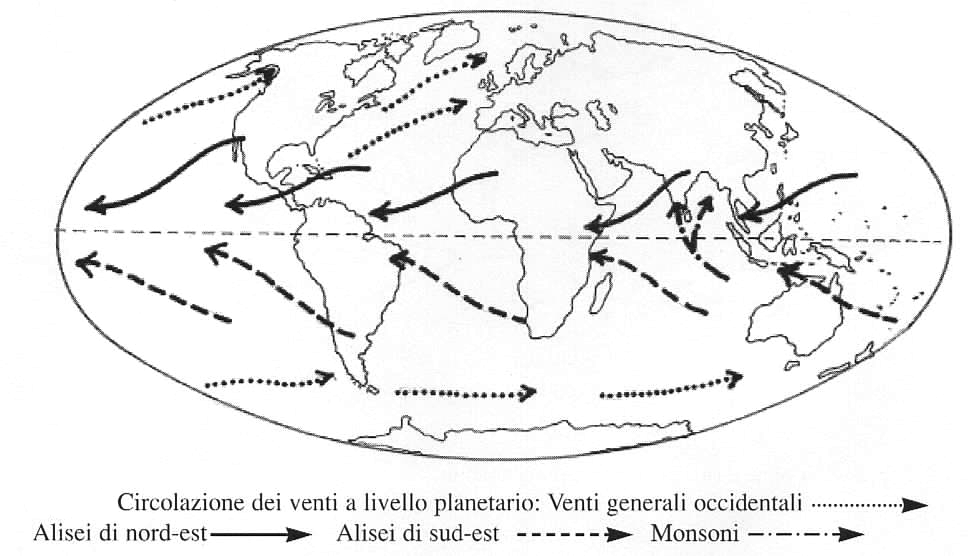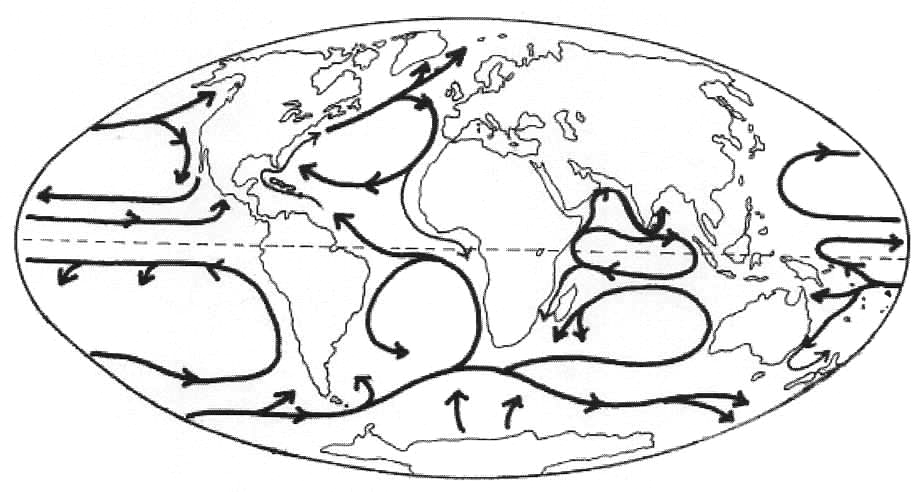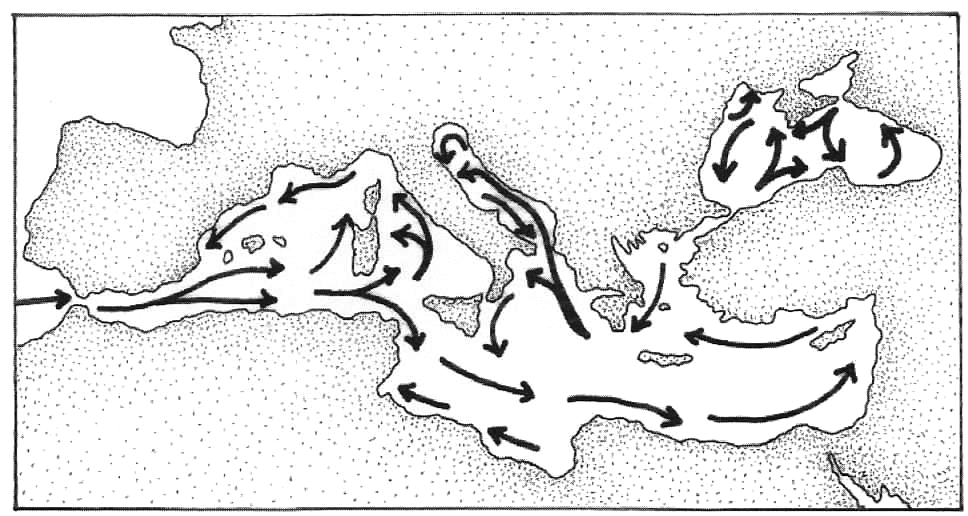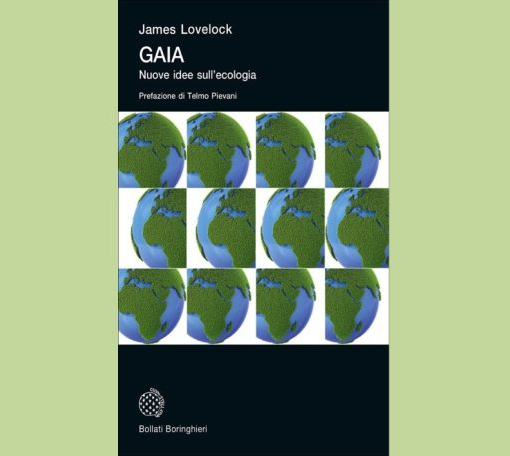
Second appointment with the movements of the waters that color our beloved planet blue. In the first we looked more closely at the “functioning” of the waves (https://www.earthgardeners.it/2023/07/27/i-ritmi-del-mare-le-onde/), in this we broaden the view and we are interested in currents.
All those who love long swims know how tiring it is to “go against the current” or how easy it is to “follow the flow”, so much so that in everyday language these expressions have acquired a metaphorical meaning, which refers to those who prefer to live in an unconventional way (even if tiring) and those who prefer to adapt to the currents of life.
We know that the Earth rotates and, due to the gravitational force, all its components move more or less together. In fact, they are involved in rotational motion in a different way, depending on their density and distance from the center of the Earth’s sphere. If you want to imagine, in particular, the consequences that rotational motion can have on the masses of water and air, you can think of a fork rotating in a plate of spaghetti: in the end all the spaghetti will be involved in the rotation. But, while the fork will drag all the spaghetti at the same speed, the Earth, being spherical, will not be able to “drag” the air masses with equal speed to the poles and the Equator. The winds generated by this movement have different characteristics, but present similar trends in the two hemispheres, starting from the Equator and going towards the poles.

The result of this set of movements of air masses are constant winds that blow from the tropics towards the equator: the north-east trade winds in the northern hemisphere and the south-east trade winds in the southern hemisphere. Other winds blow at higher latitudes in the opposite direction to that of the trade winds, the General Western Winds.
The sphericity of the Earth and the inclination of its axis make the quantities of energy that the air masses absorb from the Sun unequal: at the poles the radiation is lower because the solar rays arrive obliquely, while at the Equator, where they are perpendicular, the irradiation is greater. The alternation of the seasons due to the motion of revolution around the Sun and the inclination of the Earth’s axis is also the cause of cyclical movements of air masses, which generate seasonal winds. Finally, the unequal distribution of oceans and continents on the surface of our planet is a source of other local winds.
If on a late summer day a persistent wind begins to blow on a quiet shore, first the surface of the water ripples, then you begin to see little white “foams” offshore and soon the “white horses” arrive on the beach. If the wind blows across the beach and we have to swim back, it will be quite tiring because a surface current will have formed that has the same direction as the wind. This current will cease soon after the wind drops. Similarly, the movement of enormous masses of air, such as the Trade Winds or the General Western Winds, is the cause of the constant movement of large masses of water, which generates sea currents oriented in the same direction as the winds. They follow circular paths: two move clockwise in the northern hemisphere and three counterclockwise in the southern hemisphere.

Each of these phenomena can be more or less evident depending on the latitude, exposure and all the other factors that characterize each coast.
Warm waters from equatorial or tropical areas will thus arrive at the poles and vice versa, and both the freezing polar climates and the torrid tropical climates will be mitigated. Thus, the Gulf Stream which, starting from the tropical African coasts, reaches the North American ones and then rises towards the north-east, bathing the northern European coasts, makes the climate of the British Isles and a large part of the Scandinavian peninsula milder.
Other factors also enter into the play of the currents, such as the salt content and the temperature of the water, which are different depending on the exposure, the evaporation gradient, the supply of river water, etc. These cause differences in density in the water masses, creating further movements and mixing which give rise to other currents, more or less constant, which also affect very deep areas.
Where currents bring deep water to the surface, there is an increase in productivity. The deep waters are richer in salts and nutrients and, rising upwards, “fertilize” the more superficial waters, increasing the phytoplankton and triggering that feeding process which, passing from one ring to another, leads to the formation of large schools of fish. Estuarine environments are also particularly productive, due to the supply of nutrient-rich waters.
Our Mediterranean has a circuit of waters that starts from the Gibraltar Current. In the Mediterranean basin, water losses due to evaporation are greater than contributions; this is due to the greater salinity and lower level of our sea compared to the Atlantic Ocean. It is precisely this difference in altitude that is the cause of this incoming current, which in ancient times constituted a serious obstacle for sailors who wanted to overcome the Pillars of Hercules. The less salty and less warm water that enters generates a 14 km wide flow, which tends to arrange itself in a clockwise circuit.

The surface of the waters of the Black Sea is also higher than those of the Mediterranean, and in this case too a very fast flow of incoming cold water is produced, which can exceed 10 km/h.
In both cases, these incoming surface currents correspond to two other deeper and slower outgoing currents. It is these two pairs of currents that constitute the matrix of the Mediterranean circulation and which guarantee exchanges with the waters of the Atlantic and the Black Sea.
In this sense, we must note, in conclusion, how the limited water exchange increases the risk that a sea with heavily anthropized coasts, such as the Mediterranean, will be irremediably altered by the innumerable pollution factors to which it is subject.
Credits
Author: Anna Lacci is a scientific popularizer and expert in environmental education and sustainability and in territory teaching. She is the author of documentaries and naturalistic books, notebooks and interdisciplinary teaching aids, and multimedia information materials.
Translation by Maria Antonietta Sessa




